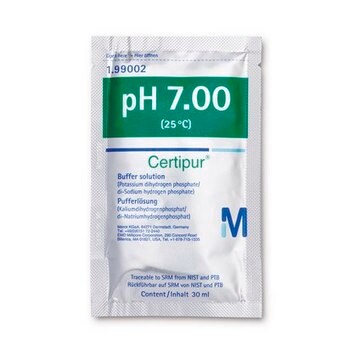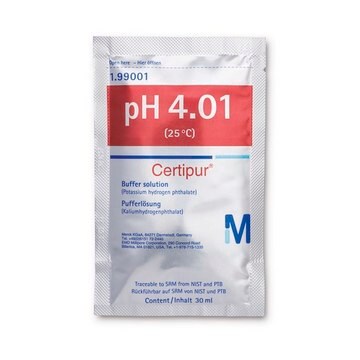1.09887
Koncentrat buforowy
(phosphate), traceable to SRM of NIST and PTB for 500 ml buffer solution, pH 7.00 ± 0.02 (20°C) Titrisol®
Synonim(y):
Koncentrat buforowy dla 500 ml roztworu buforowego, pH 7,00 ± 0,02 (20°C)
About This Item
Polecane produkty
klasa czystości
analytical standard
Poziom jakości
agency
according to DIN 19266
linia produktu
Titrisol®
pH
7.00 (20 °C in H2O)
gęstość
1.08 g/cm3 at 20 °C
Zastosowanie
environmental
food and beverages
general analytical
industrial qc
pharmaceutical
Format
mixture
temp. przechowywania
15-25°C
Powiązane kategorie
Opis ogólny
Zastosowanie
Cechy i korzyści
- Identyfikowalność z podstawowymi standardowymi materiałami referencyjnymi NIST i PTB
- Standard analityczny Grade
- Dane dotyczące niepewności i identyfikowalności są udokumentowane w kompleksowym i specyficznym dla partii certyfikacie analizy.
Komentarz do analizy
Zmierzona po rozcieńczeniu do 500 ml za pomocą szklanej elektrody kombinowanej po kalibracji wielopunktowej (zgodnie z normą DIN 19268) z materiałami referencyjnymi do przygotowania standardowych roztworów buforowych zgodnie z normą DIN 19266.
Inne uwagi
Informacje prawne
Standardowe
Kod klasy składowania
12 - Non Combustible Liquids
Klasa zagrożenia wodnego (WGK)
WGK 1
Temperatura zapłonu (°F)
Not applicable
Temperatura zapłonu (°C)
Not applicable
Certyfikaty analizy (CoA)
Poszukaj Certyfikaty analizy (CoA), wpisując numer partii/serii produktów. Numery serii i partii można znaleźć na etykiecie produktu po słowach „seria” lub „partia”.
Masz już ten produkt?
Dokumenty związane z niedawno zakupionymi produktami zostały zamieszczone w Bibliotece dokumentów.
Klienci oglądali również te produkty
Nasz zespół naukowców ma doświadczenie we wszystkich obszarach badań, w tym w naukach przyrodniczych, materiałoznawstwie, syntezie chemicznej, chromatografii, analityce i wielu innych dziedzinach.
Skontaktuj się z zespołem ds. pomocy technicznej







